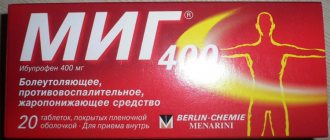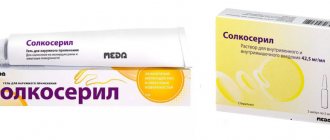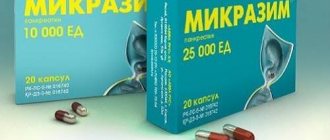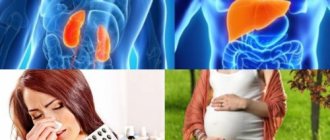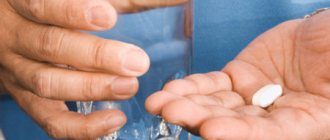Propranolol is a drug (solution) (pharmacological group - beta-blockers). The instructions for use highlight the following features of the medicine:
How to dissolve vascular plaques, normalize blood circulation, blood pressure and forget the way to the pharmacy
- Sold only with a doctor's prescription
- During pregnancy: with caution
- When breastfeeding: contraindicated
- In childhood: with caution
- For liver dysfunction: with caution
- If renal function is impaired: with caution
- In old age: with caution
Pharmacodynamics and pharmacokinetics
The medication has antiarrhythmic, antianginal, and hypotensive effects. The principle of action is based on the indiscriminate blocking of beta-adrenergic receptors, on reducing the formation of cAMP from ATP, stimulated by catecholamines, which leads to a decrease in the flow of calcium ions into the cell, negative dromo-, chrono-, bathmo-, inotropic effects are formed (myocardial contractility is reduced, excitability is inhibited and conductivity, the pulse slows down).
At the first stages of treatment on the first day, OPSS may increase as a result of the elimination of the stimulating effect of beta-2-adrenergic receptors of blood vessels in skeletal muscles, as well as as a result of a reciprocal increase in the activity of alpha-adrenergic receptors. After 1-3 days, the effect returns to the original one, and with long-term therapy it decreases. The hypotensive effect is provided by sympathetic stimulation of peripherally located vessels, a decrease in blood flow, an effect on the central nervous system, a decrease in the sensitivity of baroreceptors in the aortic arch (there is no increase in activity in response to a drop in blood pressure), a decrease in the activity of the renin-angiotensin system (especially important for patients with initial hypersecretion of renin). Stabilization of the hypotensive effect is achieved by the end of the second week of course therapy.
The antianginal effect is achieved by reducing the need for oxygen in myocardial tissue (due to negative inotropic and chronotropic effects). A decrease in heart rate improves myocardial perfusion and causes prolongation of diastole. Due to an increase in end-diastolic pressure in the left ventricle and increased stretching of the ventricular muscle tissue, an increase in oxygen demand is possible, especially this effect is recorded in patients with chronic heart failure. The antiarrhythmic effect is achieved by eliminating arrhythmogenic factors (arterial hypertension, increased cAMP content, increased activity of the sympathetic nervous system, tachycardia), slowing down atrioventricular conduction, and reducing the rate of spontaneous excitation of ectopic and sinus pacemakers. Inhibition of impulse conduction is recorded to a greater extent in the anterograde and to a lesser extent in the retrograde direction along additional pathways and through the atrioventricular node.
In the classification of antiarrhythmic drugs, Propranolol belongs to group 2 drugs. Reducing the severity of myocardial ischemia is ensured by reducing the myocardial oxygen demand. Thanks to the antiarrhythmic effect, a decrease in post-infarction mortality is achieved. The drug is able to prevent the development of headaches of vascular origin due to a decrease in the severity of cerebral vascular dilation as a result of beta-blockade of receptors in the vessels, a decrease in platelet adhesiveness, inhibition of lipolysis and platelet aggregation (under the influence of catecholamines), a decrease in renin secretion, increased stimulation of oxygen supply to tissues, preventing the activation of blood clotting factors during the release of adrenaline.
The use of the drug Propranolol leads to a decrease in the severity of tremor due to the blockade of peripherally located beta-2 adrenergic receptors. The drug can increase the atherogenic properties of blood. The medication in large dosages causes a sedative effect, increases bronchial tone, and increases contraction of the uterine walls caused by the action of drugs that stimulate the myometrium.
Beneficial properties of propranolol
Anxiety and panic disorders
The body uses a special emergency response system to protect itself from potential dangers in the world. When a person experiences a perceived threat in the environment, they initiate a stress response. This prepares the body to perform with superhuman strength and energetic capabilities.
But in today's physically and mentally demanding culture, the stress that was supposed to help us in our lives has become a big part of our lives. Stress changes the body's chemistry, providing greater strength, endless energy, and heightened awareness. However, it also places significant stress on the body's blood vessels, heart, and neurochemistry.
Ideally, the body should be completely relaxed and replenished before it becomes stressed again. But in a hectic and stressful lifestyle, this rarely happens. This has led to various physical and mental disorders and a high demand for suitable solutions to relieve stress and reverse its effects.
The leading beta-blocking agent is propranolol. It acts against the effects of adrenaline in the body. It has proven to be very effective in combating the physiological aspects of phobias, anxiety and panic disorders. []
Propranolol relieves migraines
An ongoing migraine condition can be the cause of other physical and mental health problems, including insomnia, depression, irritability and more. []
Medical treatment for migraine headaches can be in abortive or preventative forms. Abortive solutions aim to treat the acute pain caused by the onset of migraines, while preventative treatments aim to treat the conditions over time.
Research has shown that beta blockers, namely propranolol, have potential in the preventive treatment of migraine, although more research is needed to obtain effective treatment for common migraine conditions. []
Propranolol improves heart conditions
The main function of propranolol is the treatment of diseases of the heart and blood vessels, as well as various diseases that may threaten their functioning. Beta blockers relax blood vessels, lower blood pressure, and maintain good blood flow through the body's systems. []
The importance of quality blood flow should not be underestimated. Because the nutrients and oxygen contained in the blood are vital for cell survival. Due to improved circulatory functions, propranolol improves many aspects of physical health. []
Indications for use
Instructions for use of Propranolol recommend prescribing the medication for angina pectoris, arterial hypertension, sinus tachycardia, unstable angina, atrial fibrillation, supraventricular tachycardia, myocardial infarction, alcohol withdrawal (tremor, agitation), ventricular extrasystoles, atrial fibrillation, essential tremor, ventricular extrasystoles systole, thyrotoxic crisis (an auxiliary element of complex therapy), diffuse toxic goiter, with sympathoadrenal crises (concomitant diencephalic syndrome), with diffuse toxic goiter, pheochromocytoma, anxiety.
Propranolol - what is it?
Propranolol is a drug from the group of selective adrenergic blockers and has hypotensive, antiarrhythmic and antianginal effects. The drug is used in the treatment of coronary heart disease, angina pectoris, myocardial infarction, hypertension, hypertrophic cardiomyopathy, arrhythmia, heart failure, neurocirculatory dystonia, migraine and thyrotoxicosis.
| Latin name | Propranolol |
| ATX code | C07AA05 |
| Active substance | Propranolol |
| Manufacturer | Weimer Pharma GmbH (Germany) Vector (Russia) |
| Price | from 1000 rub. |
Contraindications
Propranolol is not prescribed for SA blockade, cardiogenic shock, pregnancy, cardiomegaly, Prinzmetal's angina, sinus bradycardia, sick sinus syndrome, decompensated form of CHF, acute heart failure, intolerance to the main component, COPD, arterial hypotension, bronchial asthma, psoriasis , myasthenia gravis, liver failure, breastfeeding, diabetes mellitus with ketoacidosis, occlusive pathology of peripheral vessels (complicated by pain at rest, gangrene or intermittent claudication), while taking monoamine oxidase inhibitors, metabolic acidosis.
For depression, Raynaud's syndrome, kidney pathology, allergies, thyrotoxicosis, children and the elderly, Propranolol is prescribed with caution.
Interaction with other drugs
The hypotensive effect of anaprilin is enhanced when combined with hypothiazide, reserpine, apressin and other antihypertensive drugs.
When taking sympatholytics, monoamine oxidase inhibitors, and anesthetics simultaneously, the hypotensive effect of anaprilin increases. When taking non-steroidal anti-inflammatory drugs, glucocorticosteroids and estrogens, its effect is reduced. Anaprilin prolongs the anticoagulant effect of coumarins, slows down the elimination of lidocaine, prolongs the action of non-depolarizing muscle relaxants and slows down the elimination of aminophylline, increasing its concentration in the blood.
There is data on the use of anaprilin in combination with the α-blocker phentolamine for hypertension (moderate and severe forms).
Side effects
Nervous system: increased drowsiness, fatigue, “nightmare” dreams, dizziness, weakness throughout the body, tremors of the limbs, paresthesia in the limbs (in patients with Raynaud’s syndrome, “intermittent” claudication), depression, short-term and transient memory impairment, confusion , anxiety, headaches, myasthenia gravis, asthenia, hallucinations.
Sense organs: keratoconjunctivitis, eye pain, decreased tear production, dry eyes, visual disturbances.
Cardiovascular system: arrhythmias, atrioventricular block, myocardial conduction disturbances, palpitations, sinus bradycardia, worsening of chronic heart failure, weakening of myocardial contractility, chest pain, manifestations of vasospasm (Raynaud's syndrome, coldness of the lower extremities, increased peripheral circulatory disorders), drop in level blood pressure, orthostatic hypotension.
Digestive tract: changes in taste perception, disturbances in the functioning of the hepatic system (cholestasis, yellowness of the skin and sclera, darkening of urine), stool disorders, flatulence, epigastric pain, vomiting, nausea, dry mucous membranes of the oral cavity.
Respiratory system: bronchospasm, laryngospasm, difficulty breathing, rhinitis, nasal congestion.
Endocrine system: hypoglycemia (in patients receiving insulin), decreased thyroid function, hyperglycemia (in patients suffering from non-insulin-dependent diabetes mellitus).
Allergic reactions: urticaria, skin rashes, itching.
Skin: exacerbation of psoriasis, psoriasis-like skin rashes, alopecia, exanthema, skin hyperemia, increased sweating.
Laboratory indicators: increased activity of liver enzymes, thrombocytopenia (uncharacteristic hemorrhages, bleeding), leukopenia, agranulocytosis, hyperbilirubinemia.
The effect of Propranolol on the fetus: bradycardia, hypoglycemia, intrauterine growth retardation.
Other possible adverse reactions: weakened libido, arthralgia, back pain, the formation of a “withdrawal” syndrome in the form of increased blood pressure, increased severity and frequency of angina attacks.
Society and culture[ | ]
A 1987 study by the International Conference of Symphony and Opera Musicians found that 27% of participants surveyed admitted to using beta blockers such as propranolol for musical performances. For approximately 10-16% of performers, the degree of their stage fright is considered pathological. Propranolol is used by musicians, actors, and public speakers for its ability to treat symptoms of anxiety caused by the sympathetic nervous system. It has also been used as a performance-enhancing drug in sports where high precision is required, including archery, shooting, golf and snooker. At the 2008 Summer Olympics, 50-meter pistol silver medalist and 10-meter air pistol bronze medalist Kim Jong-soo tested positive for propranolol in doping tests and was stripped of his medals.
Propranolol tablets, instructions for use (Method and dosage)
Heart rhythm disturbances, angina pectoris: 20 mg three times a day; gradually increase the dose to 120 mg (2-3 doses). The maximum daily dosage is 240 mg.
Arterial hypertension: twice a day, 40 mg. In case of ineffectiveness or weak effect, the amount of Propranolol is increased to 80 mg (2 times a day) or up to 40 mg (3 times a day). The maximum daily dosage of the drug is 320 mg (in severe, exceptional cases - 640 mg).
Essential tremor, migraine prevention: initial amount – 40 mg 2-3 times a day, later the dosage is increased to 160 mg per day. Long-acting forms of the drug (80 mg depot capsules) are taken once a day.
Thyrotoxic crisis, paroxysmal cardiac arrhythmias: intravenous, slow, jet infusion in an initial dosage of 1 mg (1 ml of 0.1% solution), repeat the procedure after 2 minutes. If ineffective, the amount of medication administered intravenously is increased to 10 mg under mandatory monitoring of ECG and blood pressure levels.
Stimulation of labor, obstetrics: 20 mg of propranolol 4-6 times at intervals of 30 minutes (daily amount 80-120 mg). In case of fetal hypoxia, the dosage is reduced. In case of pathology of the renal system, no dose adjustment is required. For liver diseases, it is necessary to reduce the amount of the drug. To prevent postpartum complications, the medication is prescribed at a dose of 20 mg 3 times a day. Course 3-5 days.
Reviews
Ekaterina, 58 years old
I have unstable angina. During attacks of exacerbation, the heart is ready to “jump” out of the chest, it hurts and knocks. Doctors advised me to take Propranolol hydrochloride tablets. I liked the effect of the medicine - my heart does not hurt, its rhythm is stabilizing, exacerbations occur less and less often. I didn’t notice any side effects from the pills.
Alexander, 34 years old
I have a hemangioma. Its therapy is dangerous, but I can’t just leave the disease like that. On the advice of my doctor, I started treatment for hemangiomas with Propranolol. I decided to undergo therapy after numerous positive reviews from Western specialists. I liked the effect of the pills - the tumor went away in six months and has not yet recurred.
Valentina, 67 years old
After myocardial infarction, my husband was in terrible condition. He constantly complained of pain in his heart and could not walk normally. Doctors prescribed him the drug Propranolol in capsules, which must be taken once a day. After three months of treatment, my husband was unrecognizable - it was as if he had never had a long-term illness or acute condition. We are happy with this effect.
Sergey, 45 years old
I take Propranolol to treat arterial hypertension. All my life I suffered from high blood pressure, but I could not even imagine that it would develop into a disease. I take pills twice a day. I noticed that on the third day of taking it, my heart stopped hurting, and my blood pressure levels returned to normal. I will continue to take the medicine.
Overdose
Manifested by bronchospasm, fainting, cyanosis of the nail plates on the fingers, ventricular extrasystole, severe bradycardia, heart failure, convulsions, arrhythmia, severe drop in blood pressure, atrioventricular block, dizziness. Treatment includes the administration of enterosorbents and, if necessary, gastric lavage. For ventricular extrasystole, lidocaine is prescribed (the use of class Ia drugs is unacceptable).
If atrioventricular conduction is impaired, 1-2 mg of atropine is administered intravenously; if ineffective, a temporary pacemaker is installed. In case of a pronounced drop in blood pressure, the patient is placed in the Tredelenburg position. For bronchospasm, beta-agonists are used parenterally or inhaled. For convulsions, intravenous infusion of diazepam is indicated. With the development of heart failure, diuretic medications, cardiac glycosides, and glucagon are prescribed. Plasma replacement solutions can be administered in the absence of signs of pulmonary edema. In case of ineffectiveness, dopamine, epinephrine, and dobutamine are administered.
Drug interactions
When used simultaneously with hypoglycemic agents, there is a risk of developing hypoglycemia due to the increased effect of hypoglycemic agents.
When used simultaneously with MAO inhibitors, there is a possibility of developing undesirable manifestations of drug interactions.
Cases of the development of severe bradycardia have been described when using propranolol for arrhythmia caused by digitalis drugs.
When used simultaneously with drugs for inhalation anesthesia, the risk of suppression of myocardial function and the development of arterial hypotension increases.
When used simultaneously with amiodarone, arterial hypotension, bradycardia, ventricular fibrillation, and asystole are possible.
When used simultaneously with verapamil, arterial hypotension, bradycardia, and dyspnea are possible. Cmax in the blood plasma increases, AUC increases, and the clearance of propranolol decreases due to inhibition of its metabolism in the liver under the influence of verapamil.
Propranolol does not affect the pharmacokinetics of verapamil.
A case of severe arterial hypotension and cardiac arrest has been described when used simultaneously with haloperidol.
When used simultaneously with hydralazine, the Cmax in the blood plasma and the AUC of propranolol increase. It is believed that hydralazine may reduce hepatic blood flow or inhibit the activity of liver enzymes, resulting in a slower metabolism of propranolol.
When used simultaneously, propranolol can inhibit the effects of glibenclamide, glyburide, chlorpropamide, tolbutamide, because Non-selective beta2-blockers are able to block pancreatic beta2-adrenergic receptors associated with insulin secretion.
The release of insulin from the pancreas due to the action of sulfonylurea derivatives is inhibited by beta-blockers, which to some extent prevents the development of the hypoglycemic effect.
When used simultaneously with diltiazem, the concentration of propranolol in the blood plasma increases due to inhibition of its metabolism under the influence of diltiazem. An additive depressant effect on cardiac function is observed due to the slowing of impulse conduction through the AV node caused by diltiazem. There is a risk of developing severe bradycardia, stroke and minute volume are significantly reduced.
With simultaneous use, cases of increased concentrations of warfarin and phenindione in the blood plasma have been described.
When used concomitantly with doxorubicin, experimental studies have shown increased cardiotoxicity.
When used simultaneously, propranolol prevents the development of the bronchodilator effect of isoprenaline, salbutamol, and terbutaline.
With simultaneous use, cases of increased concentrations of imipramine in the blood plasma have been described.
When used simultaneously with indomethacin, naproxen, piroxicam, acetylsalicylic acid, the antihypertensive effect of propranolol may be reduced.
When used simultaneously with ketanserin, an additive hypotensive effect may develop.
When used simultaneously with clonidine, the antihypertensive effect is enhanced.
In patients receiving propranolol, severe arterial hypertension may develop if clonidine is abruptly discontinued. It is believed that this is due to an increase in the content of catecholamines in the circulating blood and an increase in their vasoconstrictor effect.
When used simultaneously with caffeine, the effectiveness of propranolol may be reduced.
With simultaneous use, it is possible to enhance the effects of lidocaine and bupivacaine (including toxic ones), apparently due to a slowdown in the metabolism of local anesthetics in the liver.
When used simultaneously with lithium carbonate, a case of bradycardia has been described.
With simultaneous use, a case of increased side effects of maprotiline has been described, which is apparently due to a slowdown in its metabolism in the liver and accumulation in the body.
When used simultaneously with mefloquine, the QT interval increases, and a case of cardiac arrest has been described; with morphine - the inhibitory effect on the central nervous system caused by morphine is enhanced; with sodium amidotrizoate - cases of severe arterial hypotension have been described.
When used simultaneously with nisoldipine, an increase in the Cmax and AUC of propranolol and nisoldipine in the blood plasma is possible, which leads to severe arterial hypotension. There is a report of increased beta-blocking action.
Cases of increased Cmax and AUC of propranolol, arterial hypotension and a decrease in heart rate have been described when used simultaneously with nicardipine.
When used simultaneously with nifedipine in patients with coronary artery disease, severe arterial hypotension may develop, increasing the risk of heart failure and myocardial infarction, which may be due to an increase in the negative inotropic effect of nifedipine.
Patients receiving propranolol are at risk of developing severe hypotension after taking the first dose of prazosin.
When used simultaneously with prenylamine, the QT interval increases.
When used simultaneously with propafenone, the concentration of propranolol in the blood plasma increases and a toxic effect develops. Propafenone is believed to inhibit the hepatic metabolism of propranolol, reducing its clearance and increasing serum concentrations.
With the simultaneous use of reserpine and other antihypertensive drugs, the risk of developing arterial hypotension and bradycardia increases.
With simultaneous use, the Cmax and AUC of rizatriptan increases; with rifampicin - the concentration of propranolol in the blood plasma decreases; with suxamethonium chloride, tubocurarine chloride - the effect of muscle relaxants may change.
With simultaneous use, the clearance of theophylline decreases due to a slowdown in its metabolism in the liver. There is a risk of developing bronchospasm in patients with bronchial asthma or COPD. Beta blockers may block the inotropic effect of theophylline.
When used simultaneously with phenindione, cases of a slight increase in bleeding without changes in blood clotting parameters have been described.
When used concomitantly with flecainide, additive cardiodepressive effects are possible.
Fluoxetine inhibits the CYP2D6 isoenzyme, which leads to inhibition of the metabolism of propranolol and its accumulation and may enhance the cardiodepressive effect (including bradycardia). Fluoxetine and, mainly, its metabolites are characterized by a long T1/2, so the likelihood of drug interactions remains even several days after discontinuation of fluoxetine.
Quinidine inhibits the CYP2D6 isoenzyme, which leads to inhibition of the metabolism of propranolol, while its clearance decreases. Increased beta-blocking action and orthostatic hypotension are possible.
With simultaneous use in the blood plasma, the concentrations of propranolol, chlorpromazine, and thioridazine increase. A sharp decrease in blood pressure is possible.
Cimetidine inhibits the activity of microsomal liver enzymes (including the CYP2D6 isoenzyme), this leads to inhibition of the metabolism of propranolol and its cumulation: an increase in negative inotropic effect and the development of a cardiodepressive effect are observed.
With simultaneous use, the hypertensive effect of epinephrine is enhanced, and there is a risk of developing severe life-threatening hypertensive reactions and bradycardia. The bronchodilator effect of sympathomimetics (epinephrine, ephedrine) decreases.
With simultaneous use, cases of decreased effectiveness of ergotamine have been described.
There are reports of changes in the hemodynamic effects of propranolol when used simultaneously with ethanol.
Interaction
Extracts of allergens for skin testing, as well as allergens themselves used for immunotherapy, may increase the likelihood of developing severe systemic allergic reactions or anaphylaxis in patients taking Propranolol. X-ray contrast medications based on iodine when administered intravenously increase the risk of developing anaphylaxis. The likelihood of a drop in blood pressure and the severity of cardiodepressive effects increase with intravenous administration of phenytoin and inhaled medications for general anesthesia (hydrocarbon derivatives).
Propranolol affects the effectiveness of oral hypoglycemic agents, insulin, and is also able to mask symptoms of developing hypoglycemia such as hypertension and tachycardia. The medication increases the concentration of xanthines (an exception is difillin) and lidocaine in the blood plasma, reducing their clearance. This effect is more pronounced in patients with an initially high clearance of theophylline due to smoking. NSAIDs weaken the hypotensive effect of the drug (blockade of prostaglandin synthesis by the renal system, retention of sodium ions in the body).
Antiarrhythmic drugs, amiodarone, BMCC (diltiazem, Verapamil), guanfacine, reserpine, methyldopa, cardiac glycosides aggravate heart failure, atrioventricular block, bradycardia, and can cause cardiac arrest. Concomitant use of nifedipine causes a significant drop in blood pressure. Antihypertensive, sympatholytic, diuretic drugs, hydralazine, clonidine lead to a significant decrease in blood pressure. Propranolol can prolong the anticoagulant effect of coumarins and non-depolarizing muscle relaxants. Hypnotics, sedatives, natipsychotics (neuroleptics), tetracyclic antidepressants, tricyclic antidepressants increase the inhibitory effect on the central nervous system. It is recommended to take a break between taking propranolol and MAO inhibitors for at least 2 weeks; simultaneous use of these medications is unacceptable due to a significant increase in the hypotensive effect.
Propranolol enhances the effect of uterotonic and thyreostatic drugs and suppresses the effect of antihistamines. Non-hydrogenated ergot alkaloids increase the severity of pathology in the peripheral circulation. With simultaneous therapy with phenothiazine derivatives, an increase in the concentration of both drugs in the blood plasma is observed. Rifampin shortens the half-life, and cimetidine and sulfasalazine inhibit metabolic processes, increasing the concentration of propranolol in plasma.
Pharmainamics[ | ]
By weakening the effect of sympathetic impulses on b-adrenergic receptors in the heart, propranolol reduces the strength and frequency of heart contractions and blocks the positive chrono- and inotropic effect of catecholamines. Reduces myocardial contractility and cardiac output. Reduces heart contractions, potentiates the effect of thyreostatic drugs. Myocardial oxygen demand decreases.
Blood pressure decreases under the influence of propranolol. Bronchial tone increases due to the blockade of beta-2 adrenergic receptors. With sinus tachycardia, normalization of the rhythm is usually observed, including in the case of resistance to cardiac glycosides. The drug promotes the transition of the tachyarrhythmic form of atrial fibrillation to bradyarrhythmic and the disappearance of interruptions and heartbeats.
The drug enhances spontaneous and uterotonic contractions of the uterus. Reduces bleeding during childbirth and in the postoperative period.
Reduces intraocular pressure and reduces the secretion of aqueous humor.
special instructions
A patient taking Propranolol requires regular monitoring of blood sugar levels, ECG, blood pressure, and pulse. Elderly people require control over the condition of the renal system. The attending physician needs to teach the patient the technique of self-control of heart rate. Before treatment, patients with chronic heart failure at an early stage are prescribed diuretic medications, digitalis. A decrease in the effectiveness of the drug in “smokers” was noted. Patients who use contact lenses should be aware of a decrease in tear production while taking Propranolol.
If a diagnosis of pheochromocytoma has been established, the drug can be prescribed only after taking alpha-blockers. Abrupt withdrawal of medication in patients with thyrotoxicosis is unacceptable due to the risk of increased severity of symptoms. It is important to consider that taking propranolol against the background of thyrotoxicosis may mask the clinical signs of the disease. Caution must be exercised when treating patients who are taking hypoglycemic medications with beta-blockers (hypoglycemia is possible during long breaks).
Signs of hypoglycemia (tremor, tachycardia) can be masked by the action of propranolol. Patients should be aware that the main sign of hypoglycemia during the period of taking beta-blockers is hyperhidrosis, increased sweating. The drug is stopped several days before general anesthesia with ether or chloroform. If the patient took Propranolol before surgery, then a drug for general anesthesia is selected for him, which has the least pronounced negative inotropic effect. Reciprocal activation of the vagus nerve is eliminated by intravenous administration of atropine in an amount of 1-2 mg. Medicines that reduce the reserves of catecholamines (reserpine and others) increase the effect of yuet-adrenergic blockers, which requires constant monitoring of the patient by the attending physician for the timely detection of bradycardia and arterial hypotension. The simultaneous use of tranquilizers (anxiolytics) and neuroleptics (antipsychotics) is unacceptable. Prescribe MAO inhibitors and psychoactive medications with caution (with course therapy for more than 2 weeks).
If ventricular arrhythmias, bronchospasm, atrioventricular block, arterial hypotension, increasing bradycardia, severe kidney or liver disease are detected in elderly people, the dosage of Propranolol is reduced or the drug is discontinued. If depression develops during treatment with a beta-blocker, the drug is replaced. Abrupt discontinuation of the medication is unacceptable due to the risk of myocardial infarction and severe arrhythmias. The drug is discontinued gradually over two weeks, reducing the dosage by 25% every 3 days.
Propranolol during pregnancy and breastfeeding is prescribed in exceptional cases, if the benefit justifies the possible risk. When treating during pregnancy, careful monitoring of the condition of the fetus and mother is required. The medication is discontinued 48-72 hours before delivery. Before determining the level of normetanephrine, catecholamines, antinuclear antibody titers, and vanillylmandelic acid, the drug is discontinued.
Propranolol affects concentration and the ability to drive vehicles.
Recipe in Latin:
Rp: Tabulettam Propranololi 0.01 No. 40 Da.Signa: 1 tablet 2 times a day
Application in medicine[ | ]
Propranolol is used to treat a variety of conditions, including:
Cardiovascular[ | ]
- High blood pressure
- Angina pectoris
- Myocardial infarction
- Tachycardia (and other sympathetic nervous system symptoms such as muscle tremors) associated with various conditions including anxiety, panic, hyperthyroidism, and lithium therapy
- Portal hypertension, to reduce portal vein pressure
- Prevention of esophageal varices and ascites
- Anxiety
- Hypertrophic cardiomyopathy
Once a first-line treatment for hypertension, the role of beta blockers was downgraded in June 2006 in the United Kingdom to fourth line because they are not as effective as other drugs, especially in older people, and there is growing evidence that most Commonly used beta blockers at usual doses carry an unacceptable risk of causing type 2 diabetes.
Propranolol is not recommended for the treatment of high blood pressure by the Eighth Joint National Committee (JNC 8) because one study reported a higher incidence of the primary composite outcome of cardiovascular death, myocardial infarction, or stroke compared with an angiotensin receptor blocker.
Mental disorders[ | ]
Propranolol is sometimes used to treat anxiety, but evidence supporting its effectiveness for anxiety disorders is insufficient. Some experiments have been carried out in other psychiatric fields:
- Post-traumatic stress disorder (PTSD) and specific phobias
- Aggressive behavior in patients with brain damage
- Treatment of excessive fluid intake in psychogenic polydipsia
When prescribing propranolol to patients with mental disorders, it should be taken into account that this drug may cause or worsen depression[1].
PTSD and phobias[ | ]
Propranolol is being investigated as a potential treatment for PTSD. Propranolol interferes with the action of norepinephrine, a neurotransmitter that enhances memory consolidation. In one small study, patients treated with propranolol immediately after injury experienced fewer stress-related symptoms and lower scores of PTSD than matched controls who did not receive the drug. Because memories and their emotional content are recovered within a few hours of being recalled/re-experienced, propranolol may also reduce the emotional impact of already formed memories; for this reason, it is also being studied in the treatment of certain phobias such as arachnophobia, dental fear and social phobia.
Ethical and legal issues have been raised regarding the use of propranolol-based drugs for use as a "memory dampener", including: altering memories during investigation, altering behavioral responses to past (albeit traumatic) experiences, regulation of these medications, etc. However, Hall and Carter argue that many such objections "are based on wildly exaggerated and unrealistic scenarios that ignore the limited effects of propranolol on memory, underestimate the debilitating impact of PTSD on those suffering from it, and fail to recognize the extent to which drugs , such as alcohol, are already used for this purpose. "
Reviews of Propranolol
According to reviews, Propranolol effectively copes with all indications for the use of this medication. However, it is important to follow the instructions for use and dosages.
Reviews about the treatment of hemangioma with Propranolol
In 2008, French doctors identified the positive effect of this active drug on the fight against hemangioma. Also, you can already find examples of positive results of such treatment. However, one should remember about contraindications for the use of the drug, and also that today the drug is not protocol for the treatment of hemangioma, since the effect of this medication has not yet been sufficiently studied. In any case, you should definitely consult your doctor on this topic.
Propranolol analogs
Medicines based on the same active substance or with a similar therapeutic effect can replace the drug. These include:
- Obzidan is an Indian generic (contains the same component, but cheaper) in tablets;
- Propranolol hydrochloride is a non-selective beta-blocker in the form of a powder substance;
- Opranol is a medicine for arrhythmia;
- Anaprilin is the most common drug substitute in pharmacies and is available in tablets;
- Tenomal - contains the same active ingredient;
- Inderal - retard capsules with prolonged action.
Pregnancy and lactation
The use of propranolol during pregnancy is only possible if the expected benefit to the mother outweighs the potential risk to the fetus. If it is necessary to use it during this period, careful monitoring of the condition of the fetus is necessary; propranolol should be discontinued 48-72 hours before birth.
It should be borne in mind that a negative effect on the fetus is possible: intrauterine growth retardation, hypoglycemia, bradycardia.
Propranolol is excreted in breast milk. If it is necessary to use it during lactation, you should establish medical supervision of the child or stop breastfeeding.
Propranolol
Name:
Propranolol
Name: Propranolol (Propranololum) Indications for use: Hypertension.
Pharmacological action: By weakening the influence of sympathetic impulses on beta-adrenergic receptors of the heart, propranolol reduces the strength and frequency of heart contractions, blocks the positive chrono- and inotropic effect of catecholamines (prevents an increase in the strength and frequency of heart contractions under the influence of catecholamines). It reduces the contractility of the myocardium (heart muscle) and cardiac output. Myocardial oxygen demand decreases. Blood pressure decreases under the influence of propranolol. Bronchial tone increases due to the blockade of beta2-adrenergic receptors. For hypertension (persistent increase in blood pressure), propranolol is prescribed mainly in the initial stages of the disease. The drug is most effective in young patients (up to 40 years old) with a hyperdynamic type of blood circulation and with increased renin levels. A decrease in blood pressure is accompanied by a decrease in cardiac output due to a decrease in heart rate and a decrease in stroke volume of the heart. Peripheral resistance increases moderately. The drug does not cause orthostatic hypotension (a drop in blood pressure when moving from a horizontal to a vertical position). There is evidence of the product's effectiveness also in renal hypertension (persistent rise in blood pressure caused by kidney disease).
Propranolol method of administration and dosage: Propranolol is prescribed orally (regardless of the time of administration). Typically started in adults with a dose of 20 mg (0.02 g) 3-4 times every day. If the effect is insufficient and is well tolerated, the dose is gradually increased by 40-80 mg per day (at intervals of 3-4 days) to a total dose of 320-480 mg per day (in some cases up to 640 mg) with equal doses administered in 3-4 doses . The product is discontinued gradually. Typically, propranolol is used long-term (under close medical supervision). In patients with pheochromocytoma (tumor of the adrenal glands), alpha-blockers should be used first and simultaneously with propranolol. The hypotensive (blood pressure-lowering) effect of propranolol is enhanced when combined with hypothiazide, reserpine, apressin and other antihypertensive products. There is evidence of the use of propranolol in combination with the alpha-blocker phentolamine for hypertension (moderate and severe forms). In case of overdose of propranolol (and other beta-blockers) and persistent bradycardia, atropine solution 1-2 mg and beta-adrenergic stimulant isadrin 25 mg or orciprenaline 0.5 mg are administered intravenously (slowly).
Propranolol contraindications: The drug is contraindicated in patients with sinus bradycardia, incomplete or complete atrioventricular block (impaired conduction of excitation through the conduction system of the heart), with severe right and left ventricular heart failure, with bronchial asthma and a tendency to bronchospasm, diabetes mellitus with ketoacidosis (acidification due to for excessive levels of ketone bodies in the blood), pregnancy, disorders of peripheral arterial blood flow. It is undesirable to prescribe propranolol for spastic colitis (inflammation of the colon, characterized by sharp contractions). Caution is needed when using hypoglycemic (blood sugar-lowering) drugs at the same time (risk of hypoglycemia /lowering blood sugar levels below normal). In patients with diabetes mellitus, treatment should be carried out under the control of blood glucose levels.
Propranolol side effects: When used, side effects are possible in the form of nausea, vomiting, diarrhea (diarrhea), bradycardia (infrequent pulse), general weakness, dizziness; sometimes allergic reactions (itching of the skin), bronchospasm (narrowing of the lumen of the bronchi) are observed. Phenomena of depression (depression) are possible. Due to the blockade of beta2-adrenergic receptors in peripheral vessels, the development of Raynaud's syndrome (narrowing of the lumen of the vessels of the extremities) is possible.
Release form: Tablets of 0.01 and 0.04 g (10 and 40 mg); 0.25% solution in ampoules of 1 ml.
Synonyms: Inderal, Obzidan, Stobetin, Anaprilin, Propranolol hydrochloride, Alindol, Angilol, Antarol, Avlocardil, Bedranol, Betadren, Bricoran, Cardinol, Caridorol, Dederal, Deralin, Dociton, Elanol, Elib-lok, Indexex, Naprilin, Noloten, Opranol , Propanur, Propral, Pilapron, Sloprolol, Tenomal, Tiperal, Novo Prolol, Propra ratiopharm, Proprabene, Apopropranolol.
Storage conditions: List B. Protected from light.
Attention! Before using Propranolol, you should consult your doctor. The instructions are provided solely for information about Propranolol .
Group affiliation:
- Cardiovascular drugs
- Medicines that regulate blood pressure
Pharmacokinetics
Propranolol is resorbed from the digestive tract by more than 90% and during the initial passage through the liver is metabolized by almost 70%. Bioavailability - about 30%. With long-term use, propranolol is almost completely metabolized, and up to 18 different metabolites can be identified. 4-hydroxypropranolol has weak beta-adrenolytic activity. The volume of distribution of propranolol is 3.61 l/kg, binding to plasma proteins is 93%. The maximum concentration in blood plasma is achieved 1–2 hours after administration. Elimination of propranolol occurs primarily through the liver and more than 90% in the form of metabolites. The half-life is 3–6 hours.
Indications
Arterial hypertension; angina pectoris; supraventricular and ventricular arrhythmias; tachyarrhythmias due to glycoside intoxication; myocardial infarction; pheochromocytoma; migraine prevention; obstructive hypertrophic cardiomyopathy; essential tremor; alcohol withdrawal syndrome; prevention of recurrent bleeding from varicose veins of the esophagus; anxiety; panic attacks; thyrotoxicosis.

